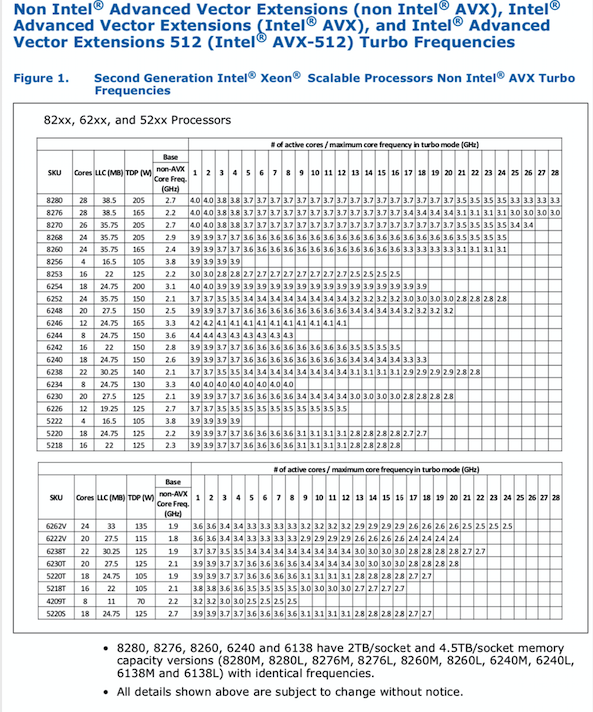Intel® Turbo Boost Technology accelerates processor performance by automatically allowing processor cores to run faster than the rated base operating frequency if they’re operating below power, current, and temperature specification limits. In general, if you don’t use all the CPU cores available, the remaining cores run faster.
This is a nice feature when mixing different core count jobs, as the processor can be used for scale out explicit workloads at the base clock rate, but give a boost for your smaller implicit workloads or license bound workloads that use less cores.
For example, if you look at the data sheet for the Intel 6252 Gold twenty four core processor, you will see the base frequency stated at 2.10 GHz, with a max turbo frequency of 3.7 GHz. What that means is if you use all 24 cores, you will expect 2.1 GHz, but if you use 1 core that remaining core can use the extra power savings to boost itself to 3.7 GHz. This is all automatic with no intervention from you as the user. The possible speedup for the remaining cores is dependent on how many cores you are using (assuming you have sufficient cooling).
Note Turbo does creates a situation that you will not see a linear speedup inside of a node when doing a scaling study ( e.g. 4 core, 8 core, 16 core, 32 core). This is because when using all the CPU cores, they run slower ( at the base rated frequency) then when you run fewer cores (that run in Turbo), and thus you will not see a linear graph.
How Much Turbo Can I Expect?
Many clients wonder how much turbo they will get if they run on less cores, especially for jobs that don’t scale to a large number of cores. This handy table from Intel below shows you based on processor, the turbo you can expect based on how many cores you are using of the total for that processor.

If you look in our example of using the Intel 6252 processor, if you ran a job using 16 of the 24 cores available on that processor, the max turbo would be 3.2 GHz ( over the base of 2.1 GHz).
Heat and Clock Rate Caveats
Note that the turbo frequency isn’t a guarantee per se, as your CPU might be running too hot, or there maybe other environmental reasons preventing the chips from reaching max turbo. In older Intel hardware, you might have AVX impacts as well.
What is “All Core Turbo?”
You might also see references to “All Core Turbo” from vendors such as AWS z1d where with special Intel chips, OS configuration, and cooling these configurations can sustain all the cores running at the rated turbo rate. All core turbo is popular with our EDA clients for workloads that tend to run single CPU jobs. TotalCAE configures our on-prem systems for all core turbo.
How Can I Check the Clock Rate?
On Linux you can use the “turbostat” command to see the clock rate details by core
So in summary, Intel Turbo Boost is a nice feature when mixing different core count jobs to get automatic speedup for cpu-bound engineering applications.
